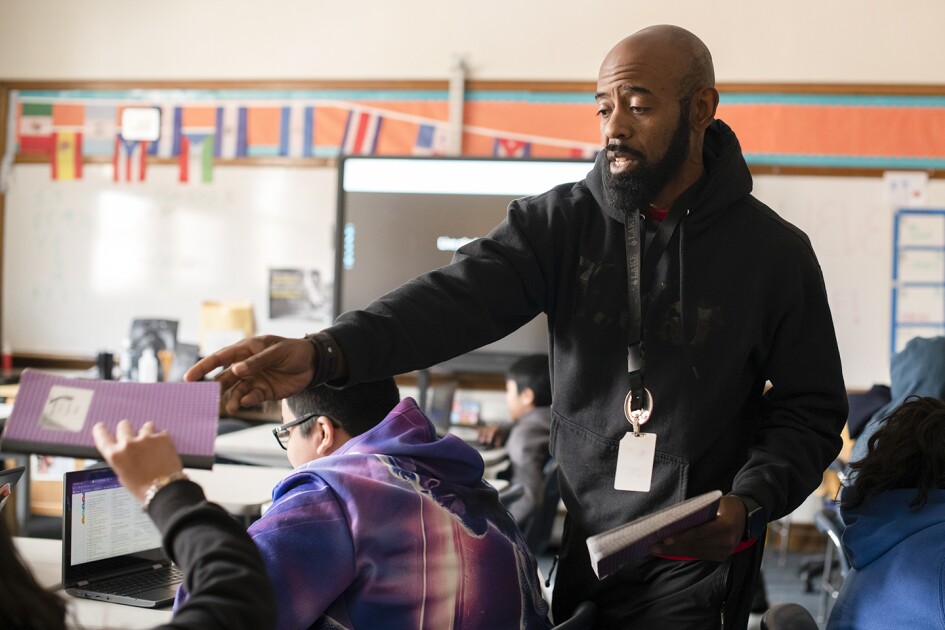Absence of Inquiry
As with many educators, the attentiveness I garnered from students was hard-won through careful crafting of lesson plans and units, reflections, and on-the-spot revisions when students weren’t engaged. I couldn’t help but be frustrated by the fact that a young male sub could produce a noticeable change in my students’ posture simply by existing in the classroom.
Suddenly, my mentor’s advice to project my voice, put my shoulders back, and avoid lowering myself physically in front of students made more sense. It’s well documented that men tend to have an upper hand on the job market, in board rooms, and in college lecture halls. The same appears to be true in the secondary classrooms.
Now entering my fourth year of teaching, I’ve had time to negotiate my authority in the classroom and to consider the ethical implications of conforming to or challenging expectations of what “the person in charge” should look and sound like. I now understand that many students may associate “good” teaching with lecture and an otherwise teacher-dominated classroom, so my objective is to correct such misconceptions early on in the semester. I tell my students that the most successful classroom sessions will be those in which they are asking the questions and doing most of the talking.
I also use classroom discussions as an opportunity to value leadership behaviors often categorized as “feminine,” like inclusiveness and collaboration. Students are rewarded for building on others’ ideas and working collaboratively to make new insights about the texts they read. In other words, they’re rewarded for becoming more effective leaders and learners.
One of my students commented in a reflection this year that he felt his discussion skills improved greatly because he learned to facilitate, rather than dominate, classroom discourse. He wrote: “It was good to try to help my peers get involved. I feel I’ve always been good at leading, but the discussions in this class made me better fit to take the backseat and allow my classmates to speak.”
‘Absence of Inquiry’
When looking for critical reflections on gender and teaching to inform my practices, however, I find that I have to rely primarily on publications geared toward educators in higher education or toward business leaders because there is a paucity of scholarly literature examining issues associated with gender and teaching at the secondary level. This absence of inquiry into gender in K-12 teaching is also problematic for the field because it means that there is a lack of community and mentorship for those who are getting started, looking for advice, or looking to advance their careers.
Granted, most teachers in K-12 education are female, so some may argue that discussions surrounding gender in classroom practice are irrelevant and that the real focus should be on recruiting more male teachers into the profession. But explorations into the role of gender in school culture could offer insights into a number of current problems in education. For example:
- Despite the prevalence of women working in schools, the majority of school superintendents are still men. In 2011, only a quarter of superintendents in the country were female, even though women comprise more than a whopping 75 percent of the total teaching workforce.
Raising Awareness, Improving Teaching
Several scholars have commented that women professors have to enact a tricky balancing act in which they must assert just enough authority (or run the risk of being reviewed negatively as “unprofessorial”) and exhibit nurturing, feminine behaviors (lest they may be written off as “cold”). It is unclear to what extent issues like these contribute to stress and overall job dissatisfaction among K-12 teachers. But more robust discussions about gender among educators, or even collaboration with faculty at the university level to flesh-out these issues, could work to produce more effective classroom management and pedagogical practices; it could also provide a new avenue for fruitful professional development opportunities.
Discussions about gender bias might also help teachers to recognize their own complicity in perpetuating problematic beliefs about men and women. After all, if teachers are still more likely to call on male students and provide them with greater intellectual challenges in the classroom, then it shouldn’t be surprising that many of those students may go on to internalize and reproduce sexist attitudes.
The ultimate goal in talking about gender in teaching is to improve education. Teacher education programs are the ideal space for helping educators to anticipate problems in teaching, find creative solutions, and spark serious academic inquiry in this neglected domain. After all, if we’re ignoring gender, then we’re not fully addressing what it means to teach and learn.






